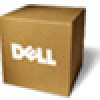Dell Optiplex-620 User Guide - Page 57
Mini Tower Computer - light codes
 |
View all Dell Optiplex-620 manuals
Add to My Manuals
Save this manual to your list of manuals |
Page 57 highlights
Back to Contents Page Mini Tower Computer Dell™ OptiPlex™ GX620 User's Guide About Your Mini Tower Computer Inside Your Computer About Your Mini Tower Computer Front View 1 CD/DVD drive Insert a CD or DVD (if applicable) into this drive. 2 floppy drive Insert a floppy disk into this drive. 3 USB 2.0 connectors (2) Use the front USB connectors for devices that you connect occasionally, such as joysticks or cameras, or for bootable USB devices (see "System Setup" for more information on booting to a USB device). It is recommended that you use the back USB connectors for devices that typically remain connected, such as printers and keyboards. 4 LAN indicator This light indicates that a LAN (network) connection is established. light 5 diagnostic lights Use the lights to help you troubleshoot a computer problem based on the diagnostic code. For more information, see "Diagnostic Lights." 6 power button Press this button to turn on the computer. NOTICE: To avoid losing data, do not turn off the computer by pressing the power button for 6 seconds or longer. Instead, perform an operating system shutdown. 7 power light NOTICE: If your operating system has ACPI enabled, when you press the power button the computer will perform an operating system shutdown. The power light illuminates and blinks or remains solid to indicate different operating modes: l No light - The computer is turned off. l Steady green - The computer is in a normal operating state. l Blinking green - The computer is in a power-saving mode. l Blinking or solid amber - See "Power Problems."















